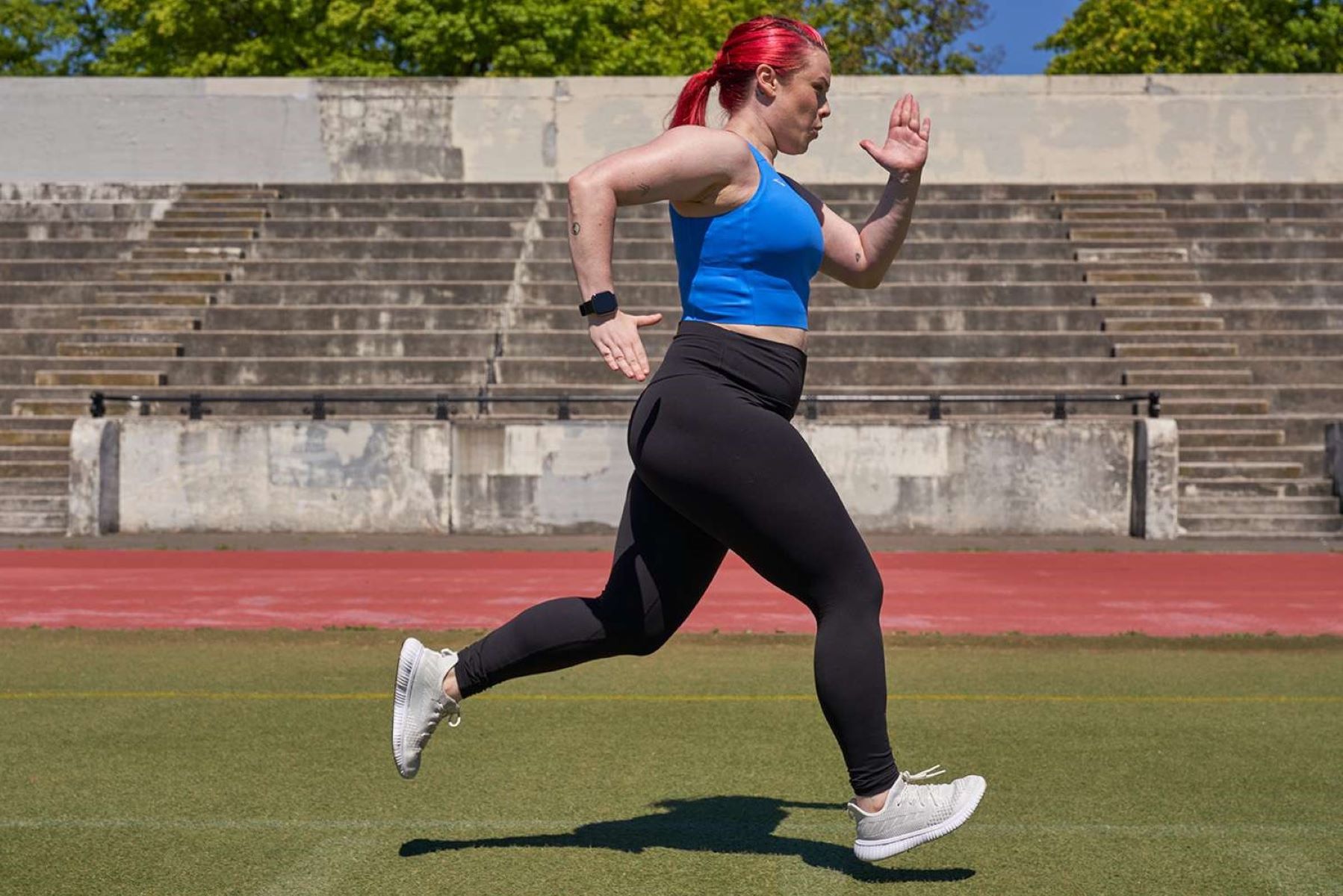

Sports
How To Sprint Faster
Published: February 28, 2024
Learn the best techniques and training tips to improve your sprinting speed in sports. Enhance your performance with expert advice and proven strategies.
(Many of the links in this article redirect to a specific reviewed product. Your purchase of these products through affiliate links helps to generate commission for Regretless.com, at no extra cost. Learn more)
Table of Contents
Introduction
Sprinting is an exhilarating and dynamic athletic endeavor that demands a combination of explosive power, agility, and speed. Whether you're a track and field athlete, a soccer player aiming to outpace opponents, or simply looking to enhance your overall fitness, improving your sprinting capabilities can be a game-changer. The ability to sprint faster not only enhances athletic performance but also contributes to overall physical health and well-being.
In this comprehensive guide, we will delve into the multifaceted aspects of sprinting and explore various strategies to help you sprint faster. From proper warm-up techniques to specialized strength training and speed workouts, we will cover a wide array of methods designed to elevate your sprinting prowess. By incorporating these strategies into your training regimen, you can unlock your full potential and achieve remarkable gains in speed and agility.
Embarking on the journey to sprint faster requires dedication, perseverance, and a willingness to push beyond your limits. It's not just about raw speed; it's about honing your technique, building strength, and cultivating explosive power. Whether you're aiming to shave milliseconds off your 100-meter dash time or seeking to outmaneuver opponents on the field, the principles and techniques outlined in this guide will serve as invaluable tools on your quest to sprint faster.
So, lace up your running shoes, prepare to break through barriers, and embrace the exhilarating challenge of enhancing your sprinting abilities. With the right mindset, training regimen, and a commitment to continuous improvement, you can elevate your sprinting performance to unprecedented levels. Let's embark on this transformative journey together and unleash the full potential of your speed and agility.
Proper Warm-Up
A proper warm-up is an essential precursor to any sprinting session, laying the foundation for optimal performance while mitigating the risk of injury. It serves as a preparatory phase that primes the body for the intense physical demands of sprinting, enhancing flexibility, blood circulation, and neuromuscular activation. A well-executed warm-up routine not only readies the muscles and joints for exertion but also sharpens mental focus, setting the stage for a productive sprinting session.
To initiate the warm-up process, begin with light cardiovascular exercises such as jogging or brisk walking. This gentle aerobic activity gradually elevates the heart rate and increases blood flow to the muscles, effectively transitioning the body from a state of rest to one of readiness for physical exertion. Following this, dynamic stretching exercises should be incorporated to enhance flexibility and range of motion in key muscle groups. Dynamic stretches, such as leg swings, high knees, and arm circles, help to loosen tight muscles and prepare them for the explosive movements characteristic of sprinting.
In addition to cardiovascular and dynamic stretching components, it is beneficial to include specific drills that mimic the movements involved in sprinting. These drills may encompass A-skips, B-skips, and high knees, among others, and are instrumental in activating the neuromuscular pathways associated with sprinting. By simulating the mechanics of sprinting during the warm-up phase, these drills effectively prime the body for the ensuing high-intensity activity, enhancing coordination and neuromuscular efficiency.
Furthermore, incorporating mobility exercises targeting the hip flexors, hamstrings, and glutes can significantly contribute to the overall effectiveness of the warm-up routine. These exercises not only enhance joint mobility and stability but also help prevent potential imbalances and injuries during sprinting. Emphasizing proper form and technique during mobility exercises is crucial, as it promotes optimal muscle activation and prepares the body for the biomechanical demands of sprinting.
In essence, a comprehensive warm-up routine should encompass cardiovascular activation, dynamic stretching, specific sprinting drills, and targeted mobility exercises. By diligently adhering to a well-structured warm-up protocol, athletes can optimize their physical readiness, minimize the risk of injury, and lay the groundwork for exceptional sprinting performance. The proper warm-up is a vital component of any sprinter's training regimen, serving as a gateway to enhanced physical preparedness and peak athletic achievement.
Technique and Form
The significance of proper technique and form in sprinting cannot be overstated. While raw speed and power are undeniably crucial, the manner in which these attributes are harnessed through precise technique and form ultimately determines the efficacy of a sprinter's performance. By honing and refining these fundamental aspects, athletes can unlock their full potential and achieve remarkable gains in speed and efficiency.
One of the foundational elements of sprinting technique is the initial body position at the starting line. Athletes must adopt a low, crouched stance with the hips positioned higher than the shoulders, enabling explosive acceleration upon the commencement of the sprint. This position optimizes the body's biomechanical leverage, facilitating a powerful and efficient push-off from the starting blocks.
As the sprint progresses, maintaining proper posture and alignment is paramount. The torso should be slightly inclined forward, promoting forward propulsion and minimizing air resistance. Simultaneously, the arms should be engaged in a controlled yet vigorous pumping motion, driving the sprinter forward with synchronized precision. This coordinated arm action complements the leg movements, generating additional momentum and propelling the athlete towards the finish line.
Furthermore, the mechanics of foot strike and stride length play a pivotal role in sprinting efficiency. Athletes should strive to achieve rapid, yet controlled, ground contact with the forefoot or midfoot, minimizing braking forces and maximizing propulsion. Additionally, maintaining an optimal stride length that suits individual biomechanics is essential. Overstriding can lead to inefficiencies and increased risk of injury, while understriding may limit speed potential. Finding the ideal balance between stride length and frequency is a hallmark of proficient sprinting technique.
A crucial aspect often overlooked is the cultivation of relaxation amidst intense physical exertion. Tension in the muscles can impede fluid movement and detract from overall speed. Therefore, sprinters must strive to strike a balance between explosive power and muscular relaxation, allowing for efficient energy transfer and unhindered forward momentum.
In essence, mastering the nuances of sprinting technique and form is a continuous process that demands meticulous attention to detail and persistent refinement. By conscientiously integrating these principles into training and competition, athletes can elevate their sprinting capabilities, surmount performance plateaus, and achieve newfound levels of speed and efficiency. The pursuit of impeccable technique and form is an ongoing endeavor, underpinning the quest for sprinting excellence and serving as a cornerstone of athletic achievement.
Strength Training
Strength training serves as a cornerstone in the quest to sprint faster, playing a pivotal role in enhancing muscular power, explosiveness, and overall athletic performance. By systematically engaging in targeted strength training exercises, athletes can fortify the musculature essential for sprinting, thereby amplifying their capacity for rapid acceleration and sustained speed.
Central to an effective strength training regimen for sprinters is the cultivation of lower body strength and power. Compound exercises such as squats, deadlifts, and lunges form the bedrock of lower body strength development, fostering robustness in the quadriceps, hamstrings, glutes, and calves. These exercises not only bolster muscular strength but also contribute to the optimization of force production during each stride, enabling athletes to generate greater propulsion with each step.
In addition to compound movements, plyometric exercises are instrumental in fortifying the explosiveness and reactive capabilities of the lower body. Plyometrics, encompassing exercises such as box jumps, depth jumps, and bounding drills, facilitate the rapid stretch-shortening cycle of muscles, thereby augmenting the rate of force development and enhancing the ability to generate explosive power during sprinting.
Furthermore, the incorporation of unilateral strength exercises, including single-leg squats and Bulgarian split squats, can rectify muscular imbalances and enhance stability, thereby fortifying the foundation for efficient sprinting mechanics. By addressing asymmetries and bolstering stability, athletes can mitigate the risk of injury and optimize their biomechanical efficiency during sprinting.
It is imperative to underscore the significance of core strength in sprinting performance. A robust and stable core serves as the linchpin for transmitting force between the upper and lower body, fostering optimal posture, and minimizing energy dissipation. Engaging in core-specific exercises such as planks, Russian twists, and medicine ball throws can fortify the abdominal, oblique, and lower back musculature, thereby enhancing overall stability and power transfer during sprinting.
Moreover, the integration of resistance training for the upper body should not be overlooked. While sprinting predominantly relies on lower body propulsion, the arms play a crucial role in generating momentum and facilitating efficient biomechanics. Incorporating exercises such as bench presses, pull-ups, and shoulder presses can bolster upper body strength, contributing to enhanced arm drive and coordination during sprinting.
In essence, a well-rounded strength training regimen tailored to the specific demands of sprinting is indispensable for athletes seeking to elevate their speed and explosiveness. By diligently integrating lower body strength exercises, plyometrics, unilateral movements, core strengthening, and upper body resistance training, athletes can fortify the physical attributes essential for sprinting prowess, thereby unlocking their full potential for speed and agility.
Plyometric Exercises
Plyometric exercises, often referred to as "plyos," are dynamic movements characterized by rapid, explosive muscle contractions that harness the stretch-shortening cycle to enhance muscular power and reactive strength. These exercises are instrumental in fortifying the lower body musculature, refining neuromuscular coordination, and augmenting the capacity for rapid force production – all of which are pivotal in sprinting faster and with greater efficiency.
One of the hallmark plyometric exercises for sprinters is the depth jump. This exercise involves stepping off a raised platform, immediately followed by an explosive upward jump upon landing. The rapid eccentric loading and subsequent concentric contraction during the jump serve to amplify muscular power and reactive capabilities, thereby enhancing the ability to generate explosive force during sprinting strides.
Another fundamental plyometric exercise is the bounding drill, which entails performing exaggerated, explosive strides characterized by maximal horizontal displacement. Bounding drills cultivate the capacity for rapid force application and aid in refining sprinting mechanics, particularly in terms of stride length and frequency. By engaging in bounding exercises, athletes can bolster their ability to cover ground swiftly and efficiently, thereby translating to enhanced sprinting speed and agility.
Furthermore, box jumps represent a quintessential plyometric exercise that targets lower body explosiveness and reactive strength. By propelling the body onto a raised platform from a stationary position, athletes can fortify their capacity for rapid force production and enhance the muscular power essential for explosive sprinting starts and accelerations.
Incorporating plyometric exercises such as single-leg hops and lateral bounds can also confer substantial benefits to sprinters. These exercises not only fortify unilateral lower body strength and stability but also refine proprioception and coordination, thereby contributing to enhanced agility and dynamic balance during sprinting maneuvers.
The efficacy of plyometric exercises lies in their ability to elicit neuromuscular adaptations that optimize the stretch-shortening cycle of muscles, thereby enhancing the rate of force development and the capacity for rapid force application. By systematically integrating plyometric exercises into their training regimen, sprinters can cultivate explosive power, refine reactive capabilities, and fortify the musculature essential for sprinting prowess.
In essence, plyometric exercises represent a cornerstone in the pursuit of sprinting excellence, serving as a potent tool for fortifying lower body explosiveness, refining neuromuscular coordination, and augmenting the capacity for rapid force production. By embracing the dynamic and explosive nature of plyometric exercises, athletes can elevate their sprinting capabilities, surmount performance plateaus, and achieve newfound levels of speed and efficiency.
Speed Workouts
Speed workouts are the cornerstone of a sprinter's training regimen, serving as the crucible in which raw potential is honed into peak athletic performance. These specialized training sessions are meticulously designed to target the physiological and biomechanical facets of sprinting, fostering the development of explosive power, speed endurance, and refined running mechanics.
One of the quintessential components of speed workouts is the incorporation of interval training. This entails alternating between periods of high-intensity sprinting and active recovery, thereby cultivating the capacity for sustained speed and enhanced cardiovascular endurance. By engaging in structured interval sessions, athletes can push their physiological thresholds, elevate their anaerobic capacity, and fortify their ability to maintain peak speed over extended distances.
Furthermore, the integration of overspeed training, facilitated through the use of resistance-assisted devices such as sleds or bungee cords, can significantly augment sprinting speed and stride frequency. By subjecting the body to resistance that exceeds normal sprinting velocities, overspeed training elicits neuromuscular adaptations that enhance the rate of force production and foster heightened turnover, thereby translating to accelerated sprinting speeds.
In addition to interval training and overspeed work, sprinters often engage in specialized drills aimed at refining running mechanics and enhancing stride efficiency. These drills may encompass A-skip variations, high knee drills, and bounding exercises, all of which serve to reinforce proper posture, optimize ground contact mechanics, and cultivate a fluid, propulsive running gait. By diligently integrating these drills into their training routine, athletes can refine their biomechanical prowess and unlock newfound levels of speed and efficiency.
Moreover, the incorporation of tempo runs, characterized by sustained efforts at near-maximal speed, plays a pivotal role in fortifying speed endurance and mental resilience. These workouts challenge athletes to sustain high velocities over extended distances, thereby enhancing their capacity to maintain speed in the latter stages of a race or competition. By systematically engaging in tempo runs, sprinters can bolster their ability to stave off fatigue and sustain peak performance throughout the duration of a sprinting event.
In essence, speed workouts represent the crucible in which sprinters forge their raw potential into refined athletic prowess. By embracing the multifaceted components of interval training, overspeed work, specialized drills, and tempo runs, athletes can elevate their speed, endurance, and running mechanics, thereby positioning themselves for unparalleled success on the track or field. Speed workouts are not merely training sessions; they are transformative crucibles that mold raw potential into peak athletic performance.
Rest and Recovery
Rest and recovery are integral components of any comprehensive training regimen, playing a pivotal role in optimizing athletic performance, mitigating the risk of overuse injuries, and facilitating the physiological adaptations essential for sprinting prowess. While the pursuit of speed and agility often emphasizes rigorous training and high-intensity workouts, the significance of adequate rest and strategic recovery cannot be overstated. In the realm of sprinting, where explosive power and rapid force production are paramount, the implementation of structured rest and recovery protocols is indispensable for sustaining peak physical readiness and maximizing training adaptations.
Central to the rest and recovery paradigm is the prioritization of adequate sleep. Quality sleep serves as the cornerstone of physiological restoration, fostering muscular repair, hormone regulation, and cognitive rejuvenation. For sprinters aiming to optimize their performance, ensuring sufficient and restorative sleep is imperative. By adhering to consistent sleep patterns and prioritizing restful slumber, athletes can facilitate the recuperative processes essential for muscular recovery and overall physical well-being.
Strategic rest intervals between high-intensity training sessions are equally crucial. While the pursuit of sprinting excellence demands rigorous exertion and maximal effort, integrating structured rest periods into the training regimen is essential for preventing overtraining and burnout. By allowing for adequate recovery between intense workouts, athletes can optimize the adaptation process, minimize the risk of injury, and sustain peak performance throughout the training cycle.
Moreover, the incorporation of active recovery modalities, such as light aerobic exercise, mobility drills, and foam rolling, can expedite the clearance of metabolic byproducts, reduce muscular tension, and enhance circulation, thereby expediting the recovery process. These low-impact activities serve to promote muscular relaxation, alleviate post-exertion soreness, and facilitate the restoration of optimal neuromuscular function, thereby priming the body for subsequent training sessions.
Nutritional strategies also play a pivotal role in the rest and recovery paradigm. Adequate hydration, balanced macronutrient intake, and strategic nutrient timing are instrumental in replenishing glycogen stores, facilitating muscle repair, and supporting the body's adaptive response to training stimuli. By adhering to a well-structured nutritional plan that aligns with the demands of sprinting, athletes can optimize recovery, fortify their physical resilience, and sustain peak performance throughout the training cycle.
In essence, rest and recovery are indispensable pillars in the pursuit of sprinting excellence. By prioritizing quality sleep, integrating strategic rest intervals, embracing active recovery modalities, and adhering to sound nutritional practices, athletes can optimize their physical readiness, mitigate the risk of overuse injuries, and position themselves for sustained peak performance. The rest and recovery paradigm is not merely a passive interlude between training sessions; it is a proactive and strategic endeavor that underpins the pursuit of sprinting excellence.
Conclusion
In the realm of athletic pursuits, the quest to sprint faster transcends mere physical exertion; it embodies a relentless pursuit of excellence, a symphony of explosive power, refined technique, and unwavering determination. Throughout this comprehensive guide, we have delved into the multifaceted dimensions of sprinting, exploring the intricate interplay of physical conditioning, biomechanical precision, and mental fortitude that underpin the pursuit of sprinting excellence.
From the foundational tenets of proper warm-up techniques to the meticulous refinement of sprinting form and mechanics, each facet of sprinting prowess represents a testament to the dedication and precision required to achieve peak performance. The integration of strength training, plyometric exercises, and specialized speed workouts serves as a testament to the holistic approach necessary for cultivating the explosive power, speed endurance, and refined running mechanics essential for sprinting faster.
Yet, amidst the rigors of training and the pursuit of athletic mastery, the significance of rest and recovery emerges as a pivotal cornerstone. The strategic implementation of rest intervals, active recovery modalities, and sound nutritional practices underscores the proactive and holistic nature of the rest and recovery paradigm, serving as a linchpin for sustaining peak physical readiness and mitigating the risk of overuse injuries.
As athletes embark on the transformative journey to sprint faster, they are not merely honing their physical capabilities; they are cultivating resilience, fortitude, and an unwavering commitment to continuous improvement. The pursuit of sprinting excellence is a testament to the indomitable human spirit, a relentless quest to transcend limitations and redefine the boundaries of speed and agility.
In the crucible of sprinting, where milliseconds delineate victory from defeat, every facet of training, technique refinement, and recovery assumes profound significance. It is a symphony of meticulous preparation, explosive execution, and unwavering resilience, culminating in the electrifying spectacle of speed and agility.
As athletes harness the collective wisdom distilled within this guide, they are poised to embark on a transformative odyssey, transcending barriers, and unlocking their full potential. The pursuit of sprinting excellence is not merely a physical endeavor; it is a testament to the unyielding human spirit, an unwavering commitment to surpassing boundaries and embracing the exhilarating challenge of sprinting faster.
So, as athletes lace up their running shoes and prepare to surge forward, they carry with them the collective wisdom, the unwavering determination, and the relentless pursuit of sprinting excellence. The finish line beckons, and within the cadence of each stride, the symphony of speed and agility unfolds—a testament to the unyielding pursuit of sprinting faster.














